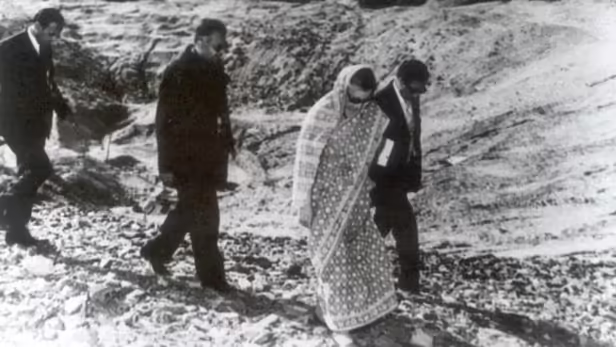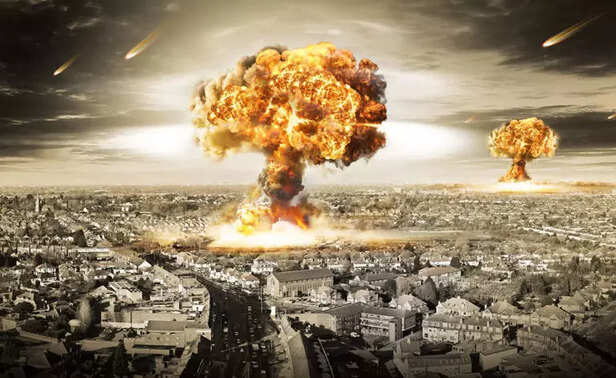What Happens If India and Pakistan Go to Nuclear War?
Nidhi | May 07, 2025, 12:49 IST

( Image credit : Times Life Bureau )
India and Pakistan are both nuclear-armed nations with a history of conflict. But what if a future war turned nuclear? This article breaks down the facts, past nuclear use, and the catastrophic consequences a strike would unleash — not just in South Asia, but across the world.
India and Pakistan have fought wars, faced multiple military standoffs, and endured decades of mistrust. But today, the stakes are higher than ever. Both are nuclear-armed nations, and as tensions escalate — especially after India’s airstrikes following the Pahalgam terror attack — the question becomes urgent:
What happens if they cross the nuclear line? 

 The world has seen the horrors of nuclear weapons — but only twice. In 1945, the U.S. dropped atomic bombs on:
The world has seen the horrors of nuclear weapons — but only twice. In 1945, the U.S. dropped atomic bombs on:
 South Asia is home to over 1.7 billion people. Densely populated cities, fragile infrastructure, and tense politics make a nuclear conflict here far more catastrophic.
South Asia is home to over 1.7 billion people. Densely populated cities, fragile infrastructure, and tense politics make a nuclear conflict here far more catastrophic.
A Princeton simulation (2020) of an India-Pakistan nuclear conflict predicted over 100 million deaths in a matter of days if both sides used ~100 weapons.

A 2019 study in Science Advances warned that a limited nuclear war between India and Pakistan could cause a worldwide food crisis, threatening 2 billion people.
Despite rising hostility, India and Pakistan have avoided full-scale war since Kargil (1999) — even during events like the 2001 Parliament attack and the 2019 Pulwama-Balakot episode. Both countries have hotlines, diplomatic backchannels, and face global pressure to de-escalate.
But the risk remains: nuclear weapons are built to deter, not to be used. Yet in a world where miscalculation or a false alarm can trigger war, even deterrence is not foolproof.
Explore the latest trends and tips in Health & Fitness, Travel, Life Hacks, Fashion & Beauty, and Relationships at Times Life!
Pokhran Test 1998
What happens if they cross the nuclear line?
Nuclear History: When Did It All Begin?

Smiling Buddha
( Image credit : Times Life Bureau )
India's Nuclear Path
- 1974: India conducted its first nuclear test at Pokhran, codenamed "Smiling Buddha". It was a peaceful nuclear explosion, but it made India the sixth country to test nuclear weapons.
- 1998: After two decades of nuclear ambiguity, India conducted five nuclear tests under Operation Shakti, officially declaring itself a nuclear weapons state.
- India has since developed a triad capability — nuclear delivery by land (Agni missiles), air (Mirage 2000, SU-30MKI), and sea (INS Arihant-class submarines).

Pakistan Nuclear test
( Image credit : Times Life Bureau )
Pakistan's Nuclear Response
- 1998: In response to India’s tests, Pakistan conducted six nuclear tests in the Chagai Hills in Balochistan, becoming the world’s seventh nuclear power.
- Pakistan maintains a first-use nuclear policy, unlike India’s declared no-first-use doctrine.
- Its arsenal includes tactical nuclear weapons (short-range for battlefield use), which adds further complexity and risk.
Current Nuclear Arsenals (as of 2024)
- India: ~172 warheads
- Pakistan: ~170 warheads
What We Learned from Hiroshima and Nagasaki

Hiroshima Nuclear attack
( Image credit : Times Life Bureau )
- Hiroshima (Aug 6) – Bomb: Little Boy (uranium)
- ~70,000 people died instantly
- Total deaths by end of 1945: ~140,000
- ~70,000 people died instantly
- Nagasaki (Aug 9) – Bomb: Fat Man (plutonium)
- ~40,000 people died instantly
- Total deaths by end of 1945: ~74,000
- ~40,000 people died instantly
Long-Term Effects
- Survivors suffered leukemia, thyroid cancers, birth defects, and chronic illnesses.
- Radiation contaminated the environment for decades.
- It took both cities over 30 years to fully recover.
What If It Happens in South Asia Today?

South Asia
( Image credit : Times Life Bureau )
1. Immediate Casualties Could Be in the Millions
- A nuclear detonation over Delhi or Karachi could kill over 1 million people instantly.
- Secondary injuries from burns, flying debris, and collapsing buildings could overwhelm all medical capacity.
2. Cities Would Be Erased
- Mumbai, Lahore, Islamabad, Bangalore — all are potential targets.
- Heat waves from the blast could cause firestorms and incinerate entire neighborhoods.
- Critical infrastructure — roads, airports, hospitals — would vanish.
3. Long-Term Radiation Effects
- Fallout clouds would travel hundreds of kilometers depending on wind direction.
- Rivers like the Indus and Ganga could be contaminated.
- Farmland would become unusable; livestock would die off.
- Radiation would linger in affected areas for decades, causing cancers, genetic mutations, and ecological collapse.
The Global Consequences: It's Not Just a Regional Disaster

Nuclear Attack
( Image credit : Times Life Bureau )
1. Nuclear Winter Could Follow
- Soot and smoke from hundreds of firestorms would rise into the stratosphere.
- This could block sunlight and cool global temperatures by up to 1.8°C for over a decade.
- Result: Global crop failures, food shortages, and famine across continents.
2. Global Economy in Shock
- Trade routes in the Indian Ocean and energy supplies from the Gulf would be disrupted.
- Major financial centers (like Mumbai) would vanish, tanking markets worldwide.
- Refugee crises would strain neighboring nations like China, Afghanistan, and Iran.
3. International Response and Escalation
- The UN Security Council would likely intervene, but global alliances could get drawn in.
- U.S., China, and Russia — all nuclear powers with stakes in South Asia — might be forced to act diplomatically or militarily.
- Global non-proliferation efforts (like the NPT) could collapse, as other countries begin rethinking nuclear deterrents.
Is There Any Way Back?
But the risk remains: nuclear weapons are built to deter, not to be used. Yet in a world where miscalculation or a false alarm can trigger war, even deterrence is not foolproof.
Explore the latest trends and tips in Health & Fitness, Travel, Life Hacks, Fashion & Beauty, and Relationships at Times Life!
Pokhran Test 1998
